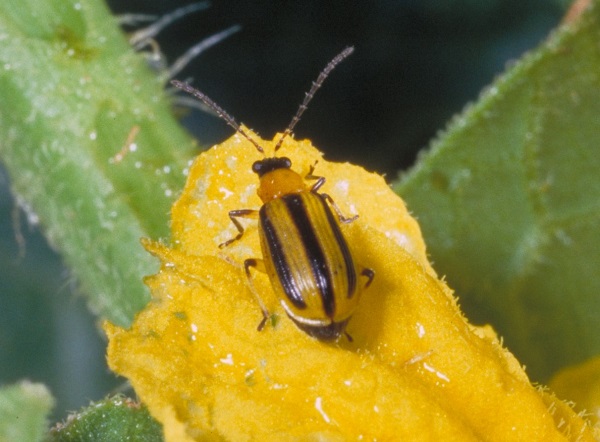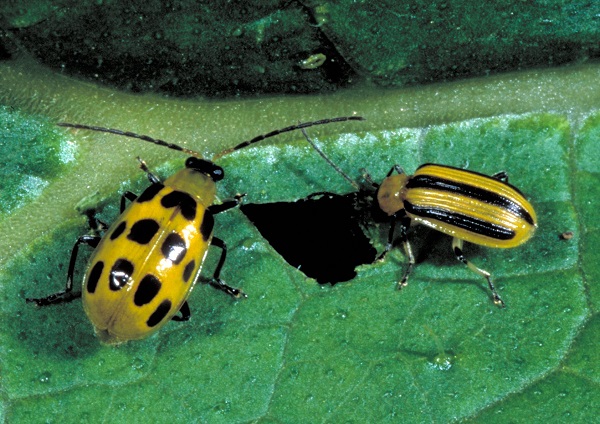Cucumber Beetles
ENTFACT-311: Cucumber Beetles | Download PDF
Ric Bessin, Extension Specialist
University of Kentucky College of Agriculture
Striped and spotted cucumber beetles can cause serious losses in cucumbers, muskmelons, and watermelons in Kentucky. Cucumber beetles are a major concern to muskmelon and cucumber growers because they vector the bacteria that causes a disease, bacterial wilt of cucurbits.
While the adults feed mainly on foliage, pollen and flowers, their feeding on melon rinds late in the season may reduce market quality. Larvae of these insects feed on roots and stems, but this damage is minimal compared to the potential losses due to bacterial wilt.

Figure 1. Striped cucumber beetles are yellow-green with three black stripes down the back and are 1/4 inch long.
Although similar in appearance, the striped cucumber beetle and the western corn rootworm are not the same. The stripes on the striped cucumber beetle are straighter than those on the western corn rootworm. Additionally, the middle segment (tibia) of the hind leg on the striped cucumber beetle is yellow, while that on the western corn rootworm is black.
The spotted cucumber beetle (also known as the southern corn rootworm), also 1/4 inch long, is yellow-green with 12 black spots on its back.

Figure 2. Spotted cucumber beetle (left) is larger on average than striped cucumber beetle (right).
Biology
Cucumber beetles overwinter as adults in protected areas near buildings, in fence rows, or in wood lots. They become active in mid-spring, when temperatures begin to increase. Currently, there is no good method for predicting when activity will begin. Beetles quickly locate host plants in the spring. The adults feed and females deposit eggs in cracks in the soil at the base of cucurbits. The eggs hatch and the larvae feed on the roots. These larvae will pupate in the soil, later in the summer the next generation of beetles will emerge. These beetles will also feed on the cucumber and melon plants, including the fruit and overwinter until the next spring.
Bacterial Wilt
The bacterium that causes bacterial wilt overwinters in the gut of some of the striped cucumber beetles. When beetles become active in the spring and begin feeding, they spread the bacterium either through their feces or from contaminated mouthparts. Chewing damage on young leaves or cotyledons open entry points for the pathogen. Once inside the plant, the bacterium multiplies quickly in the vascular system, producing blockages that cause the leaves to wilt. Beetles are attracted to infected plants and can pick up the bacterium and move it to healthy plants.
The first symptom of bacterial wilt on cucumber and muskmelon is a distinct flagging of lateral and individual leaves. Beetle feeding is not always obvious on wilted leaves. Soon, adjacent leaves and finally the entire vine will wilt. The wilting spreads as the multiplying bacteria move within the vascular system of the plant. Eventually, the entire plant wilts and dies.
There is nothing you can do to save an infected plant. The only way to avoid bacterial wilt is to prevent the beetles from feeding on the plant. Fruit produced on a wilting plant usually will not be marketable.
One way to determine if bacterial wilt has infected a plant is to cut the stem and squeeze both cut ends. A sticky sap will ooze from the water conducting tissues of the stem. If you push the cut ends of the stem together and slowly pull them apart, you will be able to see a roping effect if bacteria are present. This sap contains millions of bacteria.
Management
Begin cucumber beetle control as soon as seedlings emerge. Early treatment is essential for beetle management in large commercial muskmelon or cucumber operations. A single post-transplant soil drench with Admire or Platinum can provide near season-long control. Repeated applications of contact insecticides are necessary to protect muskmelon plants from beetle feeding and transmission of bacterial wilt. There is usually be peak in beetle activity each spring that lasts two to four weeks. This is the most important time to control the beetles. Applications of foliar insecticides may be required twice per week during peak beetle activity. Because watermelon is not susceptible to the wilt disease, protection is necessary only when plants are small and beetle populations are high.
For the home gardener, plants can be protected when they are small by mechanical means. Row covers, screens or cones over small plants are effective means of excluding cucumber beetles in home plantings.
Revised: 11/19
CAUTION! Pesticide recommendations in this publication are registered for use in Kentucky, USA ONLY! The use of some products may not be legal in your state or country. Please check with your local county agent or regulatory official before using any pesticide mentioned in this publication.
Of course, ALWAYS READ AND FOLLOW LABEL DIRECTIONS FOR SAFE USE OF ANY PESTICIDE!
Photos courtesy Ric Bessin, University of Kentucky Entomology
